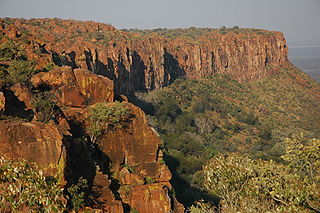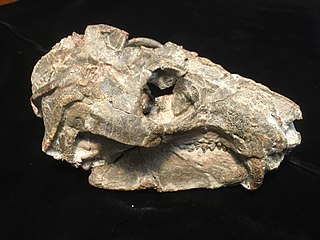 W
WThe Omingonde Formation is an Early to Middle Triassic geologic formation, part of the Karoo Supergroup, in the western Otjozondjupa Region and northeastern Erongo Region of north-central Namibia. The formation has a maximum thickness of about 600 metres (2,000 ft) and comprises sandstones, shales, siltstones and conglomerates, was deposited in a fluvial environment, alternating between a meandering and braided river setting.
 W
WAleodon is an extinct genus of cynodonts that lived from the Middle to the Late Triassic. Relatively few analyses have been conducted to identify the phylogenetic placement of Aleodon, however those that have place Aleodon as a sister taxon to Chiniquodon. Two species of Aleodon are recognized: A. brachyramphus which was discovered in Tanzania, and A. cromptoni which was discovered most recently in Brazil.
 W
WChiniquodon is an extinct genus of carnivorous cynodonts, which lived during the Late Triassic (Carnian) in South America and Africa. Chiniquodon is closely related to a contemporary genus, Probelesodon, and close to the ancestry of mammals.
 W
WCynognathus is an extinct genus of large-bodied cynodontian therapsids that lived in the Middle Triassic. It is known from a single species, Cynognathus crateronotus. Cynognathus was a 1.2-metre long predator closely related to mammals and had a southern hemispheric distribution. Fossils have so far been recovered from South Africa, Argentina, Antarctica, and Namibia.
 W
WDiademodon is an extinct genus of cynodonts. It was about 2 metres (6.6 ft) long. Although Diademodon is the most well accepted name for the genera to date, it was originally named Cynochampsa laniarius by Owen in 1860. The proposed name change occurred in 1982, where Grine defended the name proposed by Harry Seeley: Diademodon tetragonus and to be place in the group Therapsida, which was a group Owen had tiptoed around in his works on paleontology. Though Harry Govier Seeley had named Diademodon in 1894, which was after Owen had dubbed the genus Cynochampsa, Seeley had not realized the two were one and the same as the fossil that Owen named was claimed to have been found in a claystone nodule in the Renosterberg Mountains. A later paleontologist explored the same area where the fossil was claimed to have been found and declared no evidence of Cynognathus fossils.
 W
WDolichuranus is an extinct genus of dicynodont therapsids from the Middle Triassic Omingonde Formation of Namibia and the Ntawere Formation of Zambia.
 W
WErythrosuchus is an extinct genus of archosauriform reptile from the Triassic of South Africa. Remains have been found from the Cynognathus Assemblage Zone of the Beaufort Group in the Karoo of South Africa.
 W
WKannemeyeria is a genus of kannemeyeriid dicynodont that lived during the Anisian age of Middle Triassic period in what is now Africa and possibly Europe and Asia as well. The generic name is given in honor of Dr. Daniel Rossouw Kannemeyer, the South African fossil collector who discovered the original specimen. It is one of the first representatives of the family, and hence one of the first large herbivores of the Triassic.
 W
WMicrogomphodon is an extinct genus of therocephalian therapsid from the Middle Triassic of South Africa and Namibia. Currently only one species of Microgomphodon, M. oligocynus, is recognized. With fossils present in the Cynognathus Assemblage Zone (CAZ) of the Burgersdorp Formation in South Africa and Omingonde Formation of Namibia and ranging in age from late Olenekian to Anisian, it is one of the most geographically and temporally widespread therocephalian species. Moreover, its occurrence in the upper Omigonde Formation of Namibia makes Microgomphodon the latest-surviving therocephalian. Microgomphodon is a member of the family Bauriidae and a close relative of Bauria, another South African bauriid from the CAZ. Like other bauriids, it possesses several mammal-like features such as a secondary palate and broad, molar-like postcanine teeth, all of which evolved independently from mammals.
 W
WStahleckeria is an extinct genus of Middle Triassic (Ladinian) dicynodonts. It lived about 240 million years ago in what is now Brazil and Namibia. As a member of the group Kannemeyeriiformes, it was similar to the genus Kannemeyeria. The genus is known from the type species Stahleckeria potens, which was first collected from the Ladinian-age Santa Maria Formation in the Paleorrota fossil site of Brazil. Stahleckeria was named in honor of Rudolf Stahlecker, who discovered the first specimens during a 1935 expedition led by paleontologist Friedrich von Huene to the Chiniquá fossil site.
 W
WTrirachodon is an extinct genus of cynodonts. Fossils have been found in the Cynognathus Assemblage Zone of the Beaufort Group in South Africa and the Omingonde Formation of Namibia, dating back to the Early and Middle Triassic.